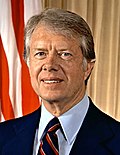 | |
| Long title | An act to establish a Department of Education, and for other purposes. |
|---|---|
| Enacted by | the 96th United States Congress |
| Citations | |
| Public law | Pub. L. 96–88 |
| Statutes at Large | 93 Stat. 668 |
| Legislative history | |
| |
| Major amendments | |
| No Child Left Behind Act of 2002 | |
The Department of Education Organization Act is a United States federal law enacted in 1979, which created the Department of Education. The new department was split off from the Department of Health, Education, and Welfare, which the Act also renamed the Department of Health and Human Services. [1]

